Abstract
The bovine cation-dependent mannose 6-phosphate receptor (CD-MPR) contains five potential N-linked glycosylation sites, four of which are utilized. To evaluate the function of these oligosaccharides, site-directed mutagenesis was used to generate glycosylation-deficient CD-MPR mutants lacking various potential glycosylation sites. The mutants were constructed in both a full-length and a soluble truncated (STOP155 construct) form of the receptor and their properties were examined in transfected COS-1 cells. The results showed that the presence of a single oligosaccharide chain, particularly at position 87, on the CD-MPR significantly enhanced its mannose 6-phosphate (Man-6-P)-binding ability when compared with non-glycosylated receptors. In addition, the presence of a single oligosaccharide chain at position 87, and to a lesser degree at position 31 or 81, promoted the secretion of the STOP155 CD-MPR. Pulse-labelling of transfected COS-1 cells followed by immunoprecipitation with binding immunoglobulin protein (BiP)-specific and CD-MPR-specific antibodies indicated that BiP associated with the non-glycosylated forms of the receptor but not with the wild-type CD-MPR. Furthermore, the association of the various glycosylation-deficient forms of the CD-MPR with BiP correlated inversely with their ability to bind Man-6-P. From these results we conclude that N-glycosylation of the bovine CD-MPR facilities the folding of the nascent polypeptide chain into a conformation that is conductive for intracellular transport and ligand binding.
Full text
PDF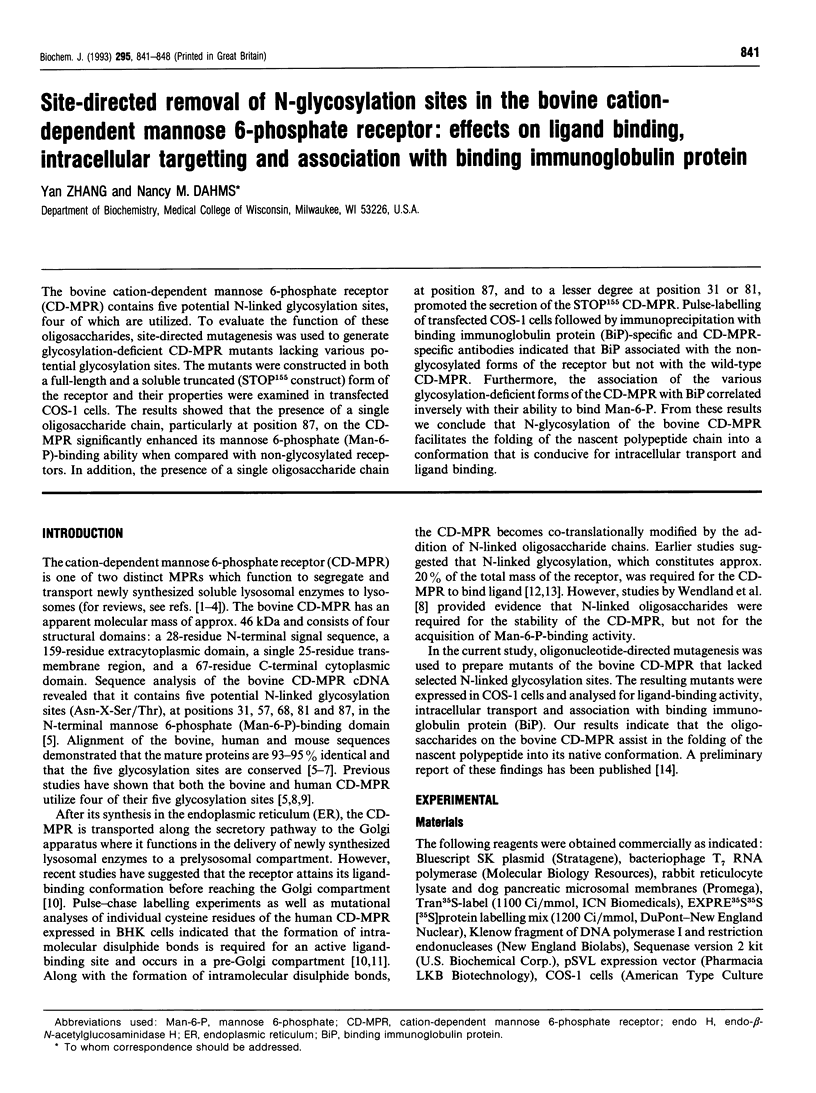
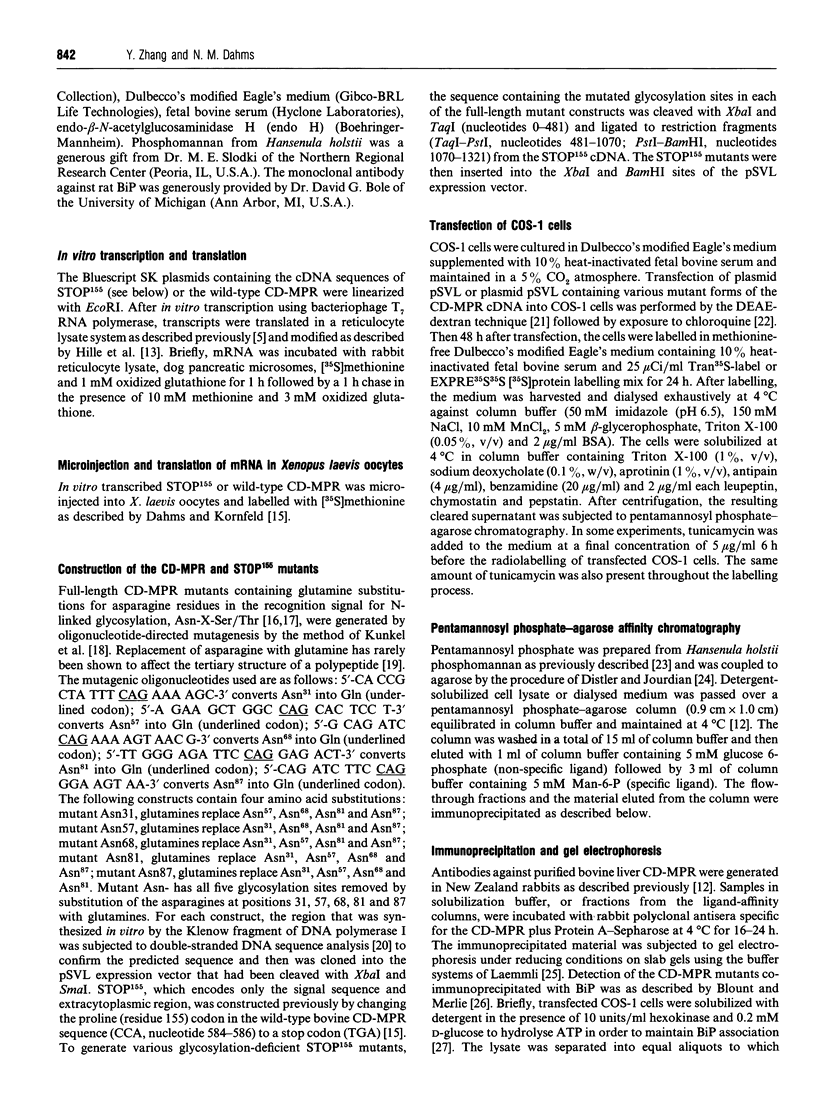
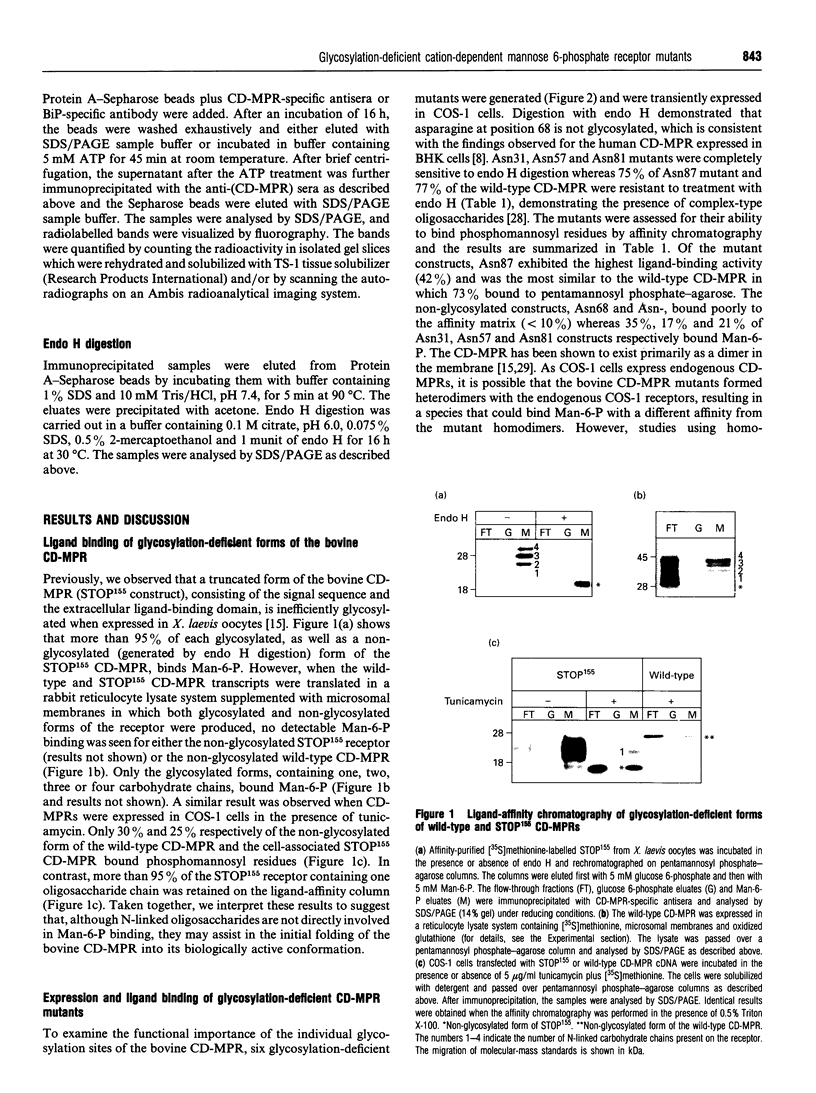
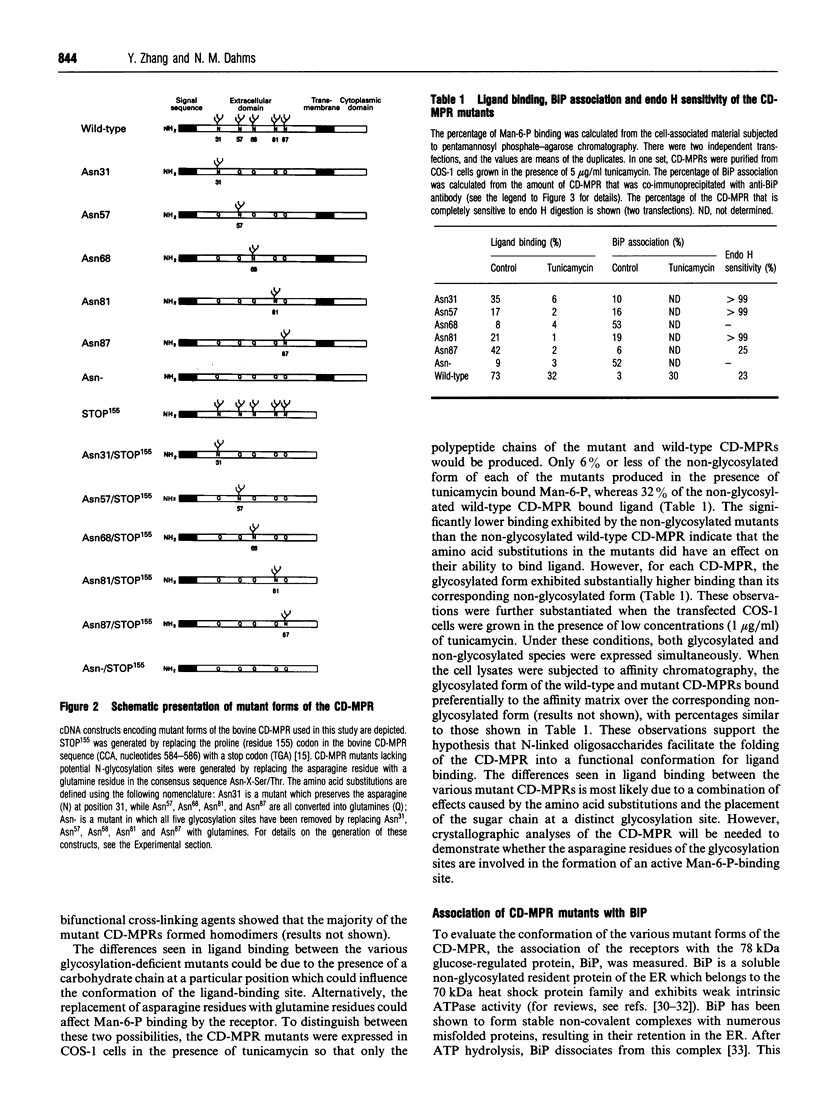
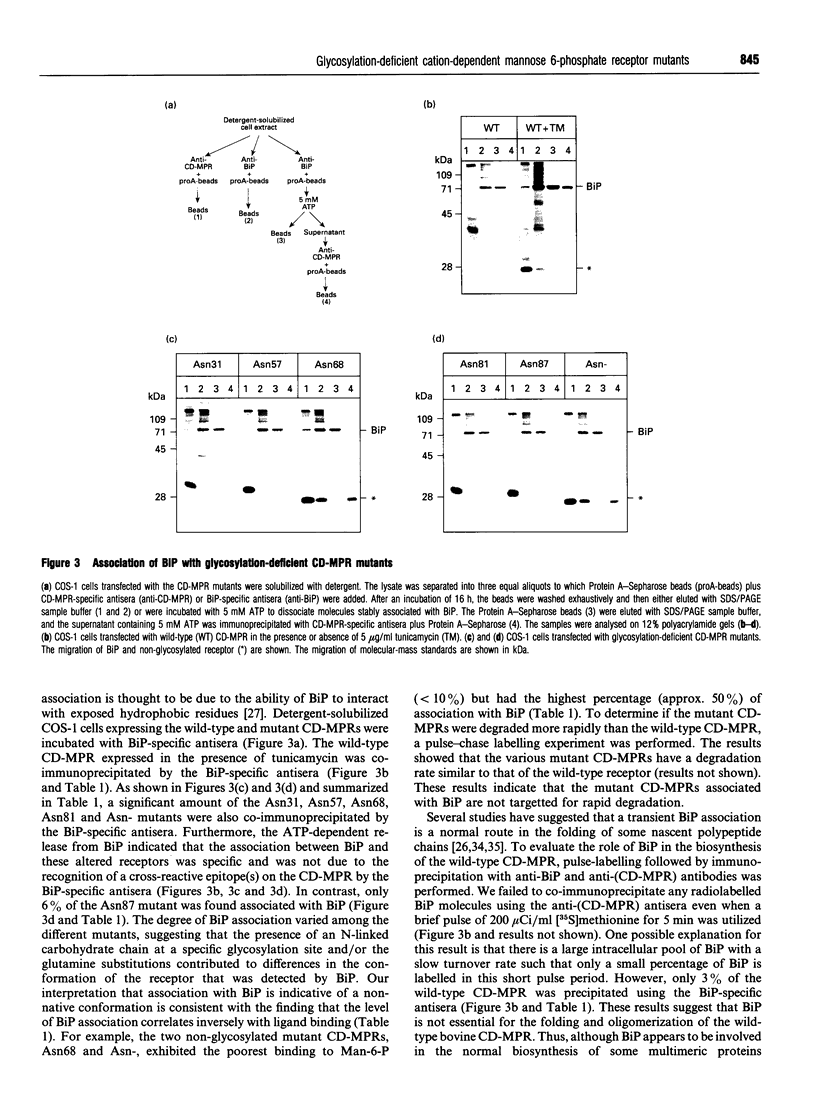
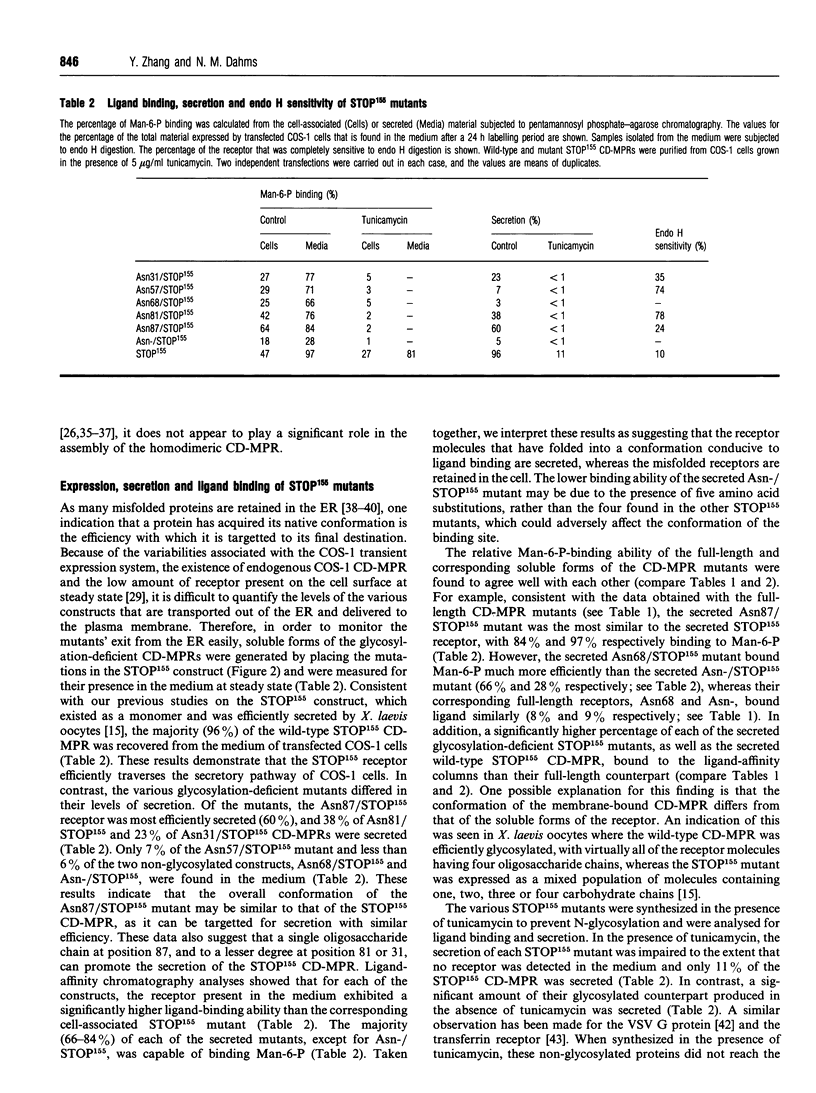
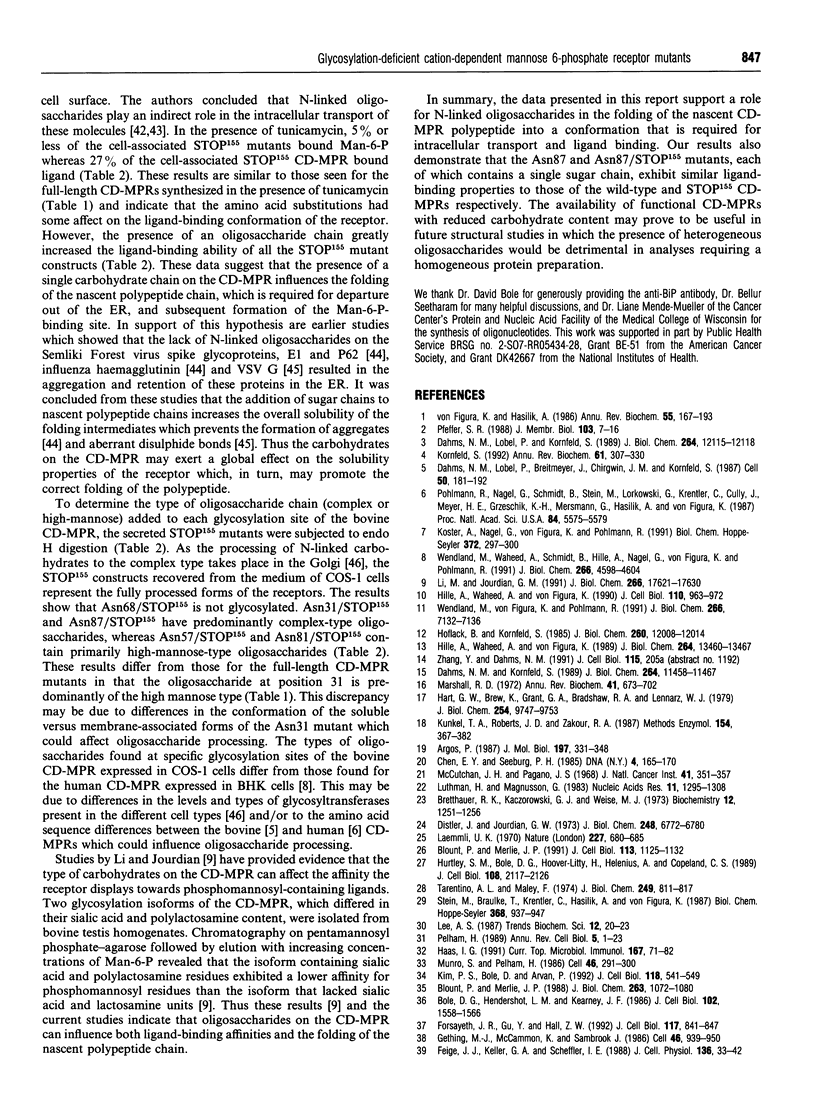

Images in this article
Selected References
These references are in PubMed. This may not be the complete list of references from this article.
- Argos P. Analysis of sequence-similar pentapeptides in unrelated protein tertiary structures. Strategies for protein folding and a guide for site-directed mutagenesis. J Mol Biol. 1987 Sep 20;197(2):331–348. doi: 10.1016/0022-2836(87)90127-6. [DOI] [PubMed] [Google Scholar]
- Blount P., Merlie J. P. BIP associates with newly synthesized subunits of the mouse muscle nicotinic receptor. J Cell Biol. 1991 Jun;113(5):1125–1132. doi: 10.1083/jcb.113.5.1125. [DOI] [PMC free article] [PubMed] [Google Scholar]
- Blount P., Merlie J. P. Native folding of an acetylcholine receptor alpha subunit expressed in the absence of other receptor subunits. J Biol Chem. 1988 Jan 15;263(2):1072–1080. [PubMed] [Google Scholar]
- Bretthauer R. K., Kaczorowski G. J., Weise M. J. Characterization of a phosphorylated pentasaccharide isolated from Hansenula holstii NRRL Y-2448 phosphomannan. Biochemistry. 1973 Mar 27;12(7):1251–1256. doi: 10.1021/bi00731a002. [DOI] [PubMed] [Google Scholar]
- Chen E. Y., Seeburg P. H. Supercoil sequencing: a fast and simple method for sequencing plasmid DNA. DNA. 1985 Apr;4(2):165–170. doi: 10.1089/dna.1985.4.165. [DOI] [PubMed] [Google Scholar]
- Dahms N. M., Kornfeld S. The cation-dependent mannose 6-phosphate receptor. Structural requirements for mannose 6-phosphate binding and oligomerization. J Biol Chem. 1989 Jul 5;264(19):11458–11467. [PubMed] [Google Scholar]
- Dahms N. M., Lobel P., Breitmeyer J., Chirgwin J. M., Kornfeld S. 46 kd mannose 6-phosphate receptor: cloning, expression, and homology to the 215 kd mannose 6-phosphate receptor. Cell. 1987 Jul 17;50(2):181–192. doi: 10.1016/0092-8674(87)90214-5. [DOI] [PubMed] [Google Scholar]
- Dahms N. M., Lobel P., Kornfeld S. Mannose 6-phosphate receptors and lysosomal enzyme targeting. J Biol Chem. 1989 Jul 25;264(21):12115–12118. [PubMed] [Google Scholar]
- Distler J. J., Jourdian G. W. The purification and properties of beta-galactosidase from bovine testes. J Biol Chem. 1973 Oct 10;248(19):6772–6780. [PubMed] [Google Scholar]
- Feige J. J., Keller G. A., Scheffler I. E. Temperature-sensitive Chinese hamster cell mutant with a defect in glycoprotein synthesis: accumulation of the EGF receptor in the endoplasmic reticulum and the role of the glucose-regulated protein GRP78. J Cell Physiol. 1988 Jul;136(1):33–42. doi: 10.1002/jcp.1041360105. [DOI] [PubMed] [Google Scholar]
- Forsayeth J. R., Gu Y., Hall Z. W. BiP forms stable complexes with unassembled subunits of the acetylcholine receptor in transfected COS cells and in C2 muscle cells. J Cell Biol. 1992 May;117(4):841–847. doi: 10.1083/jcb.117.4.841. [DOI] [PMC free article] [PubMed] [Google Scholar]
- Gething M. J., McCammon K., Sambrook J. Expression of wild-type and mutant forms of influenza hemagglutinin: the role of folding in intracellular transport. Cell. 1986 Sep 12;46(6):939–950. doi: 10.1016/0092-8674(86)90076-0. [DOI] [PubMed] [Google Scholar]
- Haas I. G. BiP--a heat shock protein involved in immunoglobulin chain assembly. Curr Top Microbiol Immunol. 1991;167:71–82. doi: 10.1007/978-3-642-75875-1_4. [DOI] [PubMed] [Google Scholar]
- Hart G. W., Brew K., Grant G. A., Bradshaw R. A., Lennarz W. J. Primary structural requirements for the enzymatic formation of the N-glycosidic bond in glycoproteins. Studies with natural and synthetic peptides. J Biol Chem. 1979 Oct 10;254(19):9747–9753. [PubMed] [Google Scholar]
- Hille A., Waheed A., von Figura K. Assembly of the ligand-binding conformation of Mr 46,000 mannose 6-phosphate-specific receptor takes place before reaching the Golgi complex. J Cell Biol. 1990 Apr;110(4):963–972. doi: 10.1083/jcb.110.4.963. [DOI] [PMC free article] [PubMed] [Google Scholar]
- Hille A., Waheed A., von Figura K. The ligand-binding conformation of Mr 46,000 mannose 6-phosphate-specific receptor. Acquisition of binding activity during in vitro synthesis. J Biol Chem. 1989 Aug 15;264(23):13460–13467. [PubMed] [Google Scholar]
- Hoflack B., Kornfeld S. Purification and characterization of a cation-dependent mannose 6-phosphate receptor from murine P388D1 macrophages and bovine liver. J Biol Chem. 1985 Oct 5;260(22):12008–12014. [PubMed] [Google Scholar]
- Hurtley S. M., Bole D. G., Hoover-Litty H., Helenius A., Copeland C. S. Interactions of misfolded influenza virus hemagglutinin with binding protein (BiP). J Cell Biol. 1989 Jun;108(6):2117–2126. doi: 10.1083/jcb.108.6.2117. [DOI] [PMC free article] [PubMed] [Google Scholar]
- Kim P. S., Bole D., Arvan P. Transient aggregation of nascent thyroglobulin in the endoplasmic reticulum: relationship to the molecular chaperone, BiP. J Cell Biol. 1992 Aug;118(3):541–549. doi: 10.1083/jcb.118.3.541. [DOI] [PMC free article] [PubMed] [Google Scholar]
- Kornfeld R., Kornfeld S. Assembly of asparagine-linked oligosaccharides. Annu Rev Biochem. 1985;54:631–664. doi: 10.1146/annurev.bi.54.070185.003215. [DOI] [PubMed] [Google Scholar]
- Kornfeld S. Structure and function of the mannose 6-phosphate/insulinlike growth factor II receptors. Annu Rev Biochem. 1992;61:307–330. doi: 10.1146/annurev.bi.61.070192.001515. [DOI] [PubMed] [Google Scholar]
- Kunkel T. A., Roberts J. D., Zakour R. A. Rapid and efficient site-specific mutagenesis without phenotypic selection. Methods Enzymol. 1987;154:367–382. doi: 10.1016/0076-6879(87)54085-x. [DOI] [PubMed] [Google Scholar]
- Köster A., Nagel G., von Figura K., Pohlmann R. Molecular cloning of the mouse 46-kDa mannose 6-phosphate receptor (MPR 46). Biol Chem Hoppe Seyler. 1991 Apr;372(4):297–300. doi: 10.1515/bchm3.1991.372.1.297. [DOI] [PubMed] [Google Scholar]
- Laemmli U. K. Cleavage of structural proteins during the assembly of the head of bacteriophage T4. Nature. 1970 Aug 15;227(5259):680–685. doi: 10.1038/227680a0. [DOI] [PubMed] [Google Scholar]
- Li M. M., Jourdian G. W. Isolation and characterization of the two glycosylation isoforms of low molecular weight mannose 6-phosphate receptor from bovine testis. Effect of carbohydrate components on ligand binding. J Biol Chem. 1991 Sep 15;266(26):17621–17630. [PubMed] [Google Scholar]
- Luthman H., Magnusson G. High efficiency polyoma DNA transfection of chloroquine treated cells. Nucleic Acids Res. 1983 Mar 11;11(5):1295–1308. doi: 10.1093/nar/11.5.1295. [DOI] [PMC free article] [PubMed] [Google Scholar]
- Machamer C. E., Rose J. K. Influence of new glycosylation sites on expression of the vesicular stomatitis virus G protein at the plasma membrane. J Biol Chem. 1988 Apr 25;263(12):5948–5954. [PubMed] [Google Scholar]
- Machamer C. E., Rose J. K. Vesicular stomatitis virus G proteins with altered glycosylation sites display temperature-sensitive intracellular transport and are subject to aberrant intermolecular disulfide bonding. J Biol Chem. 1988 Apr 25;263(12):5955–5960. [PubMed] [Google Scholar]
- Marquardt T., Helenius A. Misfolding and aggregation of newly synthesized proteins in the endoplasmic reticulum. J Cell Biol. 1992 May;117(3):505–513. doi: 10.1083/jcb.117.3.505. [DOI] [PMC free article] [PubMed] [Google Scholar]
- Marshall R. D. Glycoproteins. Annu Rev Biochem. 1972;41:673–702. doi: 10.1146/annurev.bi.41.070172.003325. [DOI] [PubMed] [Google Scholar]
- McCutchan J. H., Pagano J. S. Enchancement of the infectivity of simian virus 40 deoxyribonucleic acid with diethylaminoethyl-dextran. J Natl Cancer Inst. 1968 Aug;41(2):351–357. [PubMed] [Google Scholar]
- Munro S., Pelham H. R. An Hsp70-like protein in the ER: identity with the 78 kd glucose-regulated protein and immunoglobulin heavy chain binding protein. Cell. 1986 Jul 18;46(2):291–300. doi: 10.1016/0092-8674(86)90746-4. [DOI] [PubMed] [Google Scholar]
- Pelham H. R. Control of protein exit from the endoplasmic reticulum. Annu Rev Cell Biol. 1989;5:1–23. doi: 10.1146/annurev.cb.05.110189.000245. [DOI] [PubMed] [Google Scholar]
- Pfeffer S. R. Mannose 6-phosphate receptors and their role in targeting proteins to lysosomes. J Membr Biol. 1988 Jul;103(1):7–16. doi: 10.1007/BF01871928. [DOI] [PubMed] [Google Scholar]
- Pohlmann R., Nagel G., Schmidt B., Stein M., Lorkowski G., Krentler C., Cully J., Meyer H. E., Grzeschik K. H., Mersmann G. Cloning of a cDNA encoding the human cation-dependent mannose 6-phosphate-specific receptor. Proc Natl Acad Sci U S A. 1987 Aug;84(16):5575–5579. doi: 10.1073/pnas.84.16.5575. [DOI] [PMC free article] [PubMed] [Google Scholar]
- Stein M., Braulke T., Krentler C., Hasilik A., von Figura K. 46-kDa mannose 6-phosphate-specific receptor: biosynthesis, processing, subcellular location and topology. Biol Chem Hoppe Seyler. 1987 Aug;368(8):937–947. doi: 10.1515/bchm3.1987.368.2.937. [DOI] [PubMed] [Google Scholar]
- Tarentino A. L., Maley F. Purification and properties of an endo-beta-N-acetylglucosaminidase from Streptomyces griseus. J Biol Chem. 1974 Feb 10;249(3):811–817. [PubMed] [Google Scholar]
- Wendland M., Waheed A., Schmidt B., Hille A., Nagel G., von Figura K., Pohlmann R. Glycosylation of the Mr 46,000 mannose 6-phosphate receptor. Effect on ligand binding, stability, and conformation. J Biol Chem. 1991 Mar 5;266(7):4598–4604. [PubMed] [Google Scholar]
- Wendland M., von Figura K., Pohlmann R. Mutational analysis of disulfide bridges in the Mr 46,000 mannose 6-phosphate receptor. Localization and role for ligand binding. J Biol Chem. 1991 Apr 15;266(11):7132–7136. [PubMed] [Google Scholar]
- Williams A. M., Enns C. A. A mutated transferrin receptor lacking asparagine-linked glycosylation sites shows reduced functionality and an association with binding immunoglobulin protein. J Biol Chem. 1991 Sep 15;266(26):17648–17654. [PubMed] [Google Scholar]
- Wooden S. K., Li L. J., Navarro D., Qadri I., Pereira L., Lee A. S. Transactivation of the grp78 promoter by malfolded proteins, glycosylation block, and calcium ionophore is mediated through a proximal region containing a CCAAT motif which interacts with CTF/NF-I. Mol Cell Biol. 1991 Nov;11(11):5612–5623. doi: 10.1128/mcb.11.11.5612. [DOI] [PMC free article] [PubMed] [Google Scholar]
- von Figura K., Hasilik A. Lysosomal enzymes and their receptors. Annu Rev Biochem. 1986;55:167–193. doi: 10.1146/annurev.bi.55.070186.001123. [DOI] [PubMed] [Google Scholar]




